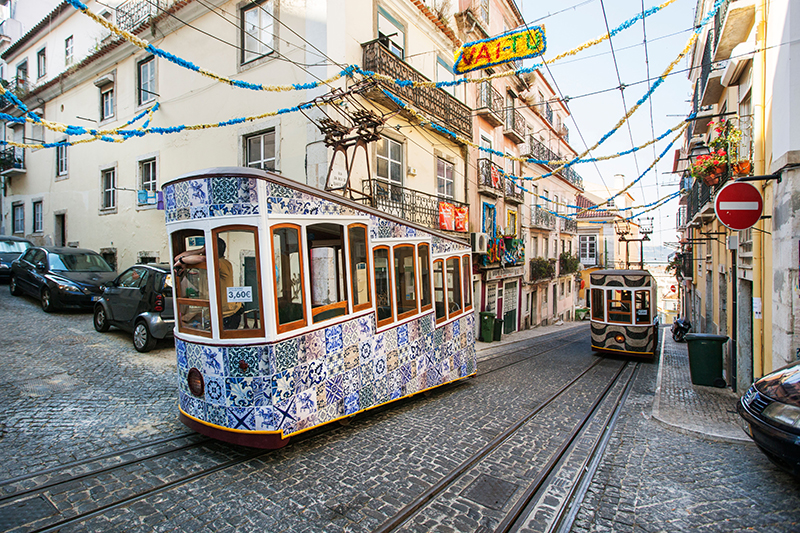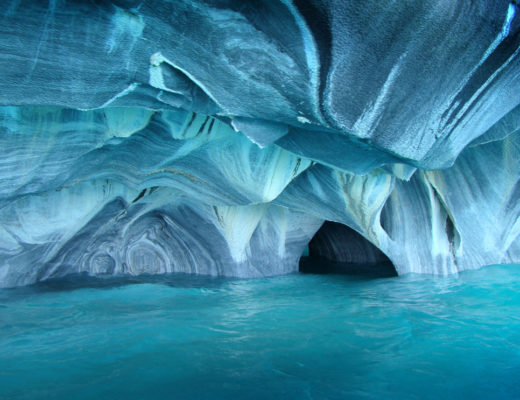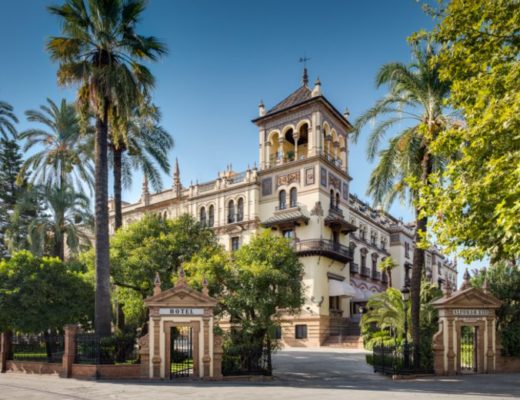Two perfect two days in Lisbon, Portugal: Things to do, places to see, food and drinks to enjoy.
To plan perfect two days in Lisbon first let’s glance at city’s layout.
Portugal’s capital sits on the north bank of Tagus estuary 17 km or 11 miles from the Atlantic coast. Lisbon has a population of about 550,000 people, but the greater Lisbon area and engulfs many villages and has nearly four times of the population. Raised to the ground by devastating earthquake of 1755, which destroyed large part of Lisbon and its surroundings, the city center is essentially 18th century, with carefully-planned elegant streets and squares of the Baixa neighborhood. Since its glory days during Age of Discovery, Lisbon was a important port. Today docks have moved with Tagus rivers and its estuary, but great monuments of the Belem district still remain.
Lisbon is divided into distinct four neighborhoods:
Alfama
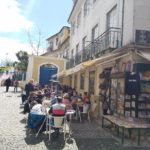
Streets-of-Alfama.
Starting from from the Easternmost part of Lisbon is Alfama district. Once the most desirable part of the city, Alfama saw most of its wealthy residents moved West for fear of earthquakes, leaving the quarter to fisherman and paupers. Ironically, most buildings survived the 1755 earthquake, and neighborhoods retains its Moorish compact houses and narrow streets. Above Alfama, the imposing Castelo de São Jorge crowns Lisbon’s eastern hill. This imposing vantage point was a defensive stronghold and royal palace until the 16th century. Today it is a popular promenade with spectacular views of Lisbon and river Tagus. West of Alfama stands proud twin towers of the Se, oldest cathedral in Lisbon, dating to 1150 AD.
Baixa and Avenida

Elevator-de-Santa-Justa.
Baixa and Avenida neighborhoods are at very center of today’s Lisbon. From the ruins of Lisbon devastated by earthquake of 1755 Marquis de Pombal created entirely new and modern city. Using a grid layout of streets he linked the stately arcaded Praca de Comercio and banks of Tagus river with busy central Rossio square. Streets of Baixa, especially Avenida da liberdade, are flanked by uniform neoclassical buildings and named according to the shopkeepers and craftsmen who traded there. Baixa is still the commercial hub of the capital, housing banks and fine shops. At its center, Rossio is popular meeting point, with cafes theaters and restaurants. The geometric layout of the area has been retained, but most of the building constructed since the mid-eighteenth-century have not adhered to Marques de Pombal formality. The streets are crowded by day, particularly the lively Rue Agusta with some great restaurants, but after dark the quarter can be deserted. Two blocks the east of Rue Augusta you will find Elevator the Santa Justa, a famous tourist site.
Bairro Alto and Estrela
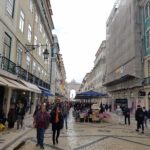
Rua-Augusta.
Laid out in a grid pattern of late 16th century, hilltop district of Bairro Alto and Estrela is most picturesque in Lisbon. Family run cheap restaurants make it popular with the locals for both food and nightlife. In Chiado part of this district, wealthy locals do their shopping. To the northwest, Estrela quarter is centered around huge Basilica de Estrela and popular gardens. Sao Roque Basilica fools tourists with its plain exterior, while surprising with remarkably rich interior. If you have time, check out Teatro Nacional de São Carlos, designed on the lines of La Scala in Milan.
Belem

Monument to the Discoveries
At the mouth of the river Tagus where explorers sailed on their Voyages of Discovery , Belem is inextricably linked with Portugal’s Golden Edge. When Manuel I came to power in 1495, he reaped profits of those heady days of expansion, building grandiose monuments and churches that mirror the spirit of the time. Two finest examples of exuberant and exotic Manueline style of architecture are Mosteiro dos Jerónimos and Torre de Belem. Don’t forget a photo in front of Monument to the Discoveries, another of Lisbon’s famous landmarks.
Day 1 of the perfect two days in Lisbon:
Transportation and accommodations:

Sheraton-Lisbon-Hotel-Spa
After passing customs and collecting our luggage we went outside of the main gate of the Lisbon’s International Airport and caught the taxi within few minutes. Taxis in Portugal are fairly inexpensive and are safe and easy mode of transportation. Ride to our hotel in the center of the town was the about 20 euros. We struck a conversation with our driver, who was a college graduate and spoke an excellent English, and hired him for a for our day trip to Sintra Palace next day.
After 20 min ride from airport, we arrived at Sheraton Lisboa Hotel & Spa two and a half hours before check-in time. Sheraton Lisboa is a modern hotel in a center of the Baixa business district. Due to booming tourist and business demand, hotel was fully booked. It did not help that KPMG global accounting conference was taking place there as well. Fortunately with my Platinum SPG status we were checked in within 20 minutes and upgraded to a nice deluxe room on the top floor, with full lounge access. I was still full from the flight, and neither of us felt in need of having a lunch so, we took a quick shower unpacked changed and at about 2pm hit the town.
Sightseeing in Belem
It was partly sunny, 60F with heavy winds and a rain coming in every 20 to 30 minutes so we decided to hit the farthest neighborhood from our hotel, and went to Belem district. Lisbon has a great public transportation system. However, since I don’t pay for flights and hotels by using points and miles, I tend to splurge to save time whenever possible. Buses, metro and trams are readily available and are safe and cheap, but we took a taxi right in front of our hotel. Taxi ride took about 15 minutes and cost around 10 euros.
Mosteiro dos Jeronimos

Mosteiro-dos-Jeronimos
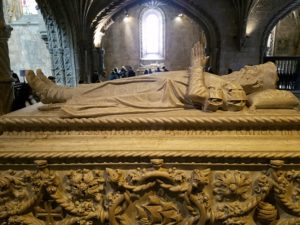
Vasco-da-Gama
We exited right in front of Mosteiro dos Jeronimos and faced huge line of tourist. About 45 minutes of standing in line! Fortunately I used Tiqets smartphone app to buy tickets on my phone and in less than 10 minutes we were entering the monastery and a beautiful gothic church with the remains of Vasco da Gama and other famous Portuguese. Mosteiro dos Jeronimos is the culmination of Manueline architecture, commissioned by Manuel I in 1501 and paid for with taxes levied on trade with New World. Take in a beautiful Tomb of Vasco da Gama, spectacular vaulting in Nave (church of Santa Maria) and tiled walls of Refectory. Allow at least 1 hour for this site.
Torre de Belem and Monument to the Voyages.
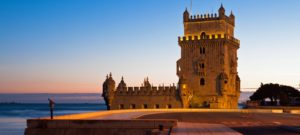
torre-belem
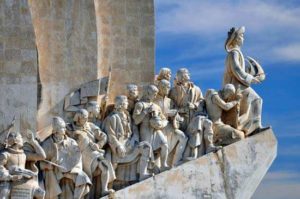
Monument to the Discoveries
After taking in sites of Mosteiro, we decided to walk to Torre de Belem and Monument to the Voyages. To cross busy Avenida da India running parallel to Tagus river use an underground crossing. Torre de Belem was built as a fortress in middle of river Tagus in 1521. Its purpose to defend capital and its port, Torre de Belem became symbol of Portugal’s area of expansion. Real beauty of Torre de Belem lies in its exterior, so if the line to enter is long, feel free to skip it and enjoy the exterior.
Dinner
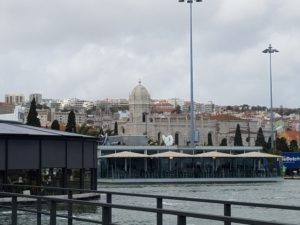
restaurant-Belem

Coffee-Lisbon
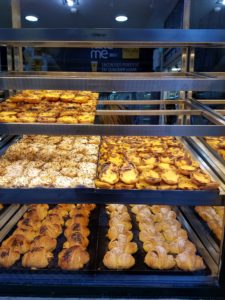
Pastry-Lisbon
The view of Tagus river with angry waves entering the Atlantic was truly breathtaking. Heavy wind and rain, however, made it less enjoyable to stand outside then to have some drinks and tapas inside one of many waterfront restaurants. We chose one at random and enjoy the wonderful views with wine and food. It was a great choice. Food in Lisbon is inexpensive, even in tourist areas and house wine is always good. We spend couple hours enjoying this view and stepping out on the patio to take pictures between the rain bands.
Nightcap
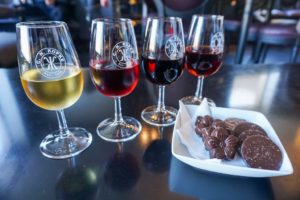
Port and chocolate
By the time we got to Sheraton Lisboa Hotel & Spa it was already around 8 p.m., so we walked into business lounge for some complimentary port wine and cheese. Lounge is located on top floor of Sheraton hotel, giving one spectacular views of Lisbon on par with 5 star restaurant located on same floor. Another great benefit of SPG Platinum member. With port and cheese on our plates and lights of Lisbon below us, perfect day 1 in Lisbon, Portugal was over.
Perfect Day 2, Lisbon and Sintra
Breakfast

Breakfast-Lisbon
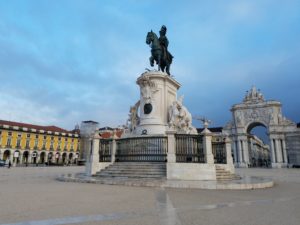
Praca-do-Commercio
My wife is not a big breakfast person and frankly neither am I, this will be a repeated theme throughout our travels. However, I did feel like having some strong coffee and I did get tempted by the nice buffet breakfast provided complementary to the SPG Platinum members in the Sheraton Business Lounge. I also knew that this will be a busy day involving lots of walking and hiking, so I fueled up and took some fruits and coffee for my wife.
After breakfast I went for an hour walk from hotel to Praca de Comercio (about 2 miles). I do this routinely when I travel for few reasons. It gives my wife time to get ready, allows me to take photos in areas not yet crowded by tourists, and allows me to take in sights as only locals going to work and about their daily chore do. Plus it is as good of the exercise as walking on a treadmill.

Sintra-Palace
Sintra Palace
At 9 a.m. our will taxi driver from day before picked us up from front of Sheraton hotel and we went for a half day trip to the amazing Sintra Palace lying just outside of Lisbon. I will describe that trip in my next post. To read more about our trip to Sintra click here.
Afternoon in Lisbon
Alfama
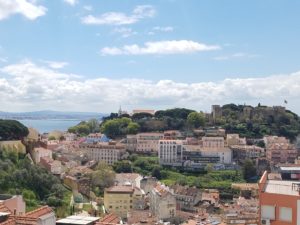
Castelo de Sao Jorge
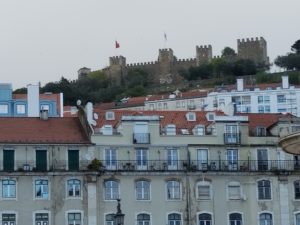
Castelo-de-Sao-Jorge
After visiting Sentra we asked our driver to drop us off at Castelo de Sao Jorge. I chose that destination for two reasons it was the farthest attraction from our hotel within walking distance and located at the highest part of Lisbon. Following recapture of Lisbon from Moors in 1147, King Alfonso Henriques transformed hilltop citadel in to residence of Portuguese kings. Destroyed during earthquake of 1755, Salazar rebuild the wall in 1938 adding gardens and wildfowl. We walked around the walls and the neighborhood enjoying local shops and amazing view from the hilltop. There are many cafes and restaurants that were truly tempting, but our driver recommend seafood place in the Baixa area of Lisbon.
Baixa and Avenida
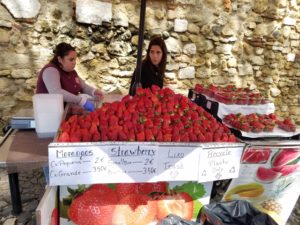
Lisbon-strawberries
We walked through winding and narrow streets of Alfama district towards Se. It is a nice walk and some people take an old tram that is a staple of Lisbon. Once in Baixa we went toward Rossio, attractive paved square that is a social point with cafes, pastry stores and National Theater to the North. Exit the northwest corner to visit Rossio train station, eye catching 19th century building, where you can catch express train to Porto. Exiting to the southwest corner and about 200 meters away you will find iconic Elevator de Santa Justa. This neo-gothic lift was built at the turn of the 20th century by French architect, apprentice to Alexandre Gustave Eiffel.
From here we proceeded to Praca do Commercio known to locals as Palace Square. This huge square engulfed by Royal Palace (after it was moved from Castelo de São Jorge), Arco de Rua Augusta and facing Tagus river was a witness to assassination of last Portuguese king and his son as well as to the start of Carnation Revolution.
Dinner

Douro red wine
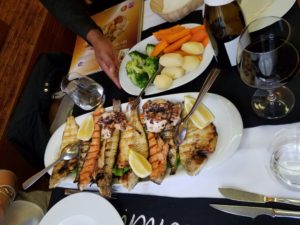
Seafood-dinner

steamed-barnacles
Finally we walked through Arco da Rua Augusta, named after connecting street with many great restaurants and cafes. Settling on recommended traditional Portuguese seafood place, we rested, enjoying bottles of wine and loads of local seafood: fresh fish and steamed barnacles.
Best part of our stay here were Lisboetas, locals. People throughout Portugal are extremely friendly and try to make you stay joyful.
Our second perfect day in Lisbon came to the end. I can only hope this article will help you plan your amazing stay in Lisbon.

